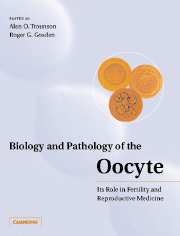Book contents
- Frontmatter
- Contents
- List of contributors
- Preface
- Part I Historical perspective
- Part II Life cycle
- Part III Developmental biology
- Part IV Pathology
- 13 Morphology and pathology of the human oocyte
- 14 The legacy of mitochondrial DNA
- 15 Aneuploidy in ageing oocytes and after toxic insult
- 16 Genetic basis of primary ovarian failure
- Part V Technology and clinical medicine
- Index
13 - Morphology and pathology of the human oocyte
from Part IV - Pathology
Published online by Cambridge University Press: 05 August 2016
- Frontmatter
- Contents
- List of contributors
- Preface
- Part I Historical perspective
- Part II Life cycle
- Part III Developmental biology
- Part IV Pathology
- 13 Morphology and pathology of the human oocyte
- 14 The legacy of mitochondrial DNA
- 15 Aneuploidy in ageing oocytes and after toxic insult
- 16 Genetic basis of primary ovarian failure
- Part V Technology and clinical medicine
- Index
Summary
Introduction
The human oocyte is a remarkable cell, unique in many respects. Although overtly unspecialized in comparison with the sperm cell, it is equipped to fuse with and incorporate the sperm cell at fertilization and sustain early embryonic development, since the embryo inherits most of its cytoplasm and, of course, the maternal genome.
Although the sperm contributes the paternal chromosomes and the dominant centrosome (cell centre) that initiates embryonic development, it contributes very little cytoplasm apart from the plasma membrane (PM) and scant perinuclear substance, midpiece and tail components, the fate of which we know very little about.
The mature oocyte is one of the largest cells (100- 120 μm in diameter) produced by the female body and is surrounded by a gelatinous glycoprotein shell (20-30 μm thick), the zona pellucida (ZP), and several layers of follicular cells, composing the cumulus oophorus, at ovulation. Its sole function is procreation and propagation of both the somatic and germ cell lines to successive generations. To this end, the oocyte shows unique adaptations in both structure and function, which are the focus of this chapter - which will also include some pathological features of the oocyte at retrieval and cover some of the changes induced by ovarian stimulation, culture and ageing in vitro.
Methodology
This chapter on the fine structure and pathology of the human oocyte is based on 23 years of research where over 2300 eggs were examined by transmission electron microscopy (TEM) in conjunction with research on various methods of assisted reproduction including intracytoplasmic sperm injection (ICSI). The eggs were routinely fixed in glutaraldehyde/ osmium tetroxide, flat embedded in araldite, serially sectioned (thick and thin) and examined by TEM (Sathananthan, 2000). The oocytes were usually recovered after gonadotropin stimulation, or after downregulation using gonadotropin-releasing factor (GNRH). Oestradiol estimation, laparoscopy and ultrasound were used for oocyte retrieval. The oocytes, unfertilized and fertilized, were obtained from various assisted reproductive technology (ART) centres in Australia and elsewhere.
Preovulatory oocytes
At oocyte retrieval, some oocytes are still immature and are at stages ranging from metaphase I (MI) to metaphase II (MII). However, with recent ovarian stimulation protocols using GNRH agonists/follicle stimulating hormone (FSH) and better timing of gonadotropins (HCG), the majority of oocytes approach MII and can be easily harvested for ART and identified, particularly when ICSI is the procedure of choice.
- Type
- Chapter
- Information
- Biology and Pathology of the OocyteIts Role in Fertility and Reproductive Medicine, pp. 185 - 208Publisher: Cambridge University PressPrint publication year: 2003
- 4
- Cited by



